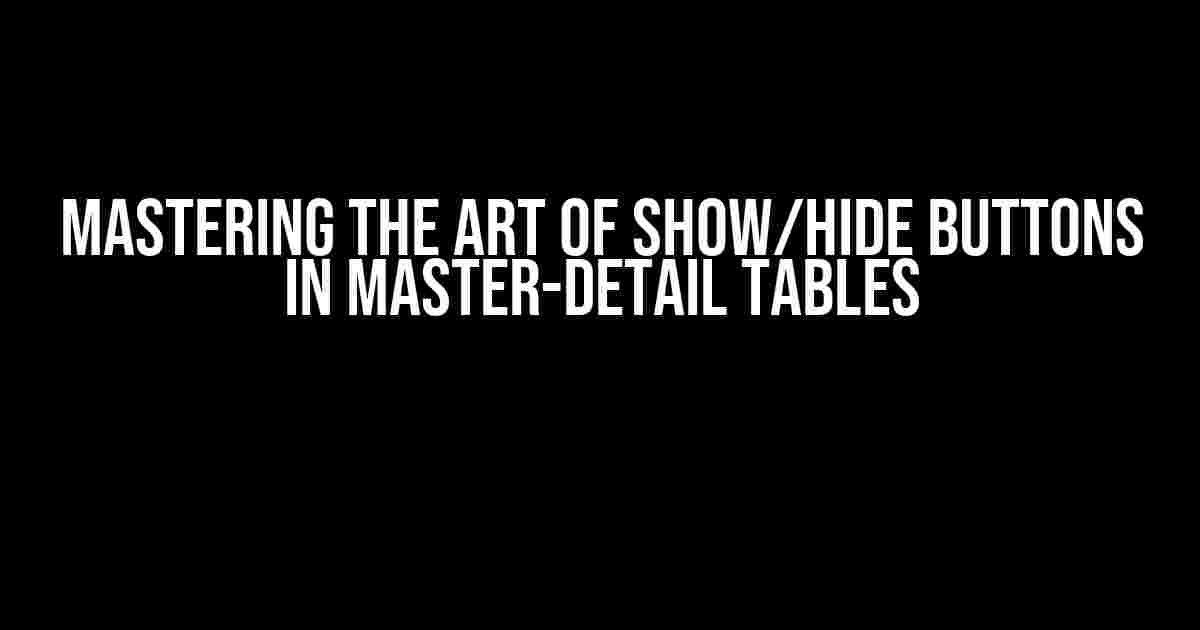When working with master-detail tables, one of the most common requirements is to include a show/hide button that appears in every row. This button allows users to expand or collapse the details section, providing a more intuitive and organized user experience. In this article, we’ll dive into the world of master-detail tables and explore the best practices for implementing show/hide buttons that appear in every row.
Understanding Master-Detail Tables
Master-detail tables are a type of data presentation that consists of a master table and a detail table. The master table displays a list of main records, while the detail table shows additional information related to each record. This format is commonly used in various applications, such as e-commerce platforms, inventory management systems, and more.
| Master Table | Detail Table |
|---|---|
|
|
The Importance of Show/Hide Buttons
Show/hide buttons play a crucial role in master-detail tables by allowing users to toggle the visibility of the detail section. This feature enhances the user experience in several ways:
- Reduces clutter: By hiding the detail section by default, the master table becomes less cluttered, making it easier to scan and navigate.
- Improves performance: Hiding unnecessary data reduces the amount of data being loaded, resulting in faster page loads and improved performance.
- Enhances accessibility: Show/hide buttons provide an intuitive way for users to control the amount of information displayed, making the application more accessible to users with disabilities.
Implementing Show/Hide Buttons in Every Row
To implement show/hide buttons in every row of the master table, you’ll need to follow these steps:
Step 1: Add a Column for the Button
<table id="master-table">
<tr>
<th>Column 1</th>
<th>Column 2</th>
<th></th> <!-- Add an empty column for the button -->
</tr>
</table>
Step 2: Add the Button to Each Row
<table id="master-table">
<tr>
<td>Record 1</td>
<td>Data 1</td>
<td><button>Show/Hide</button></td>
</tr>
<tr>
<td>Record 2</td>
<td>Data 2</td>
<td><button>Show/Hide</button></td>
</tr>
<tr>
<td>Record 3</td>
<td>Data 3</td>
<td><button>Show/Hide</button></td>
</tr>
</table>
Step 3: Add JavaScript to Toggle the Detail Section
<script>
const masterTable = document.getElementById("master-table");
const rows = masterTable.rows;
rows.forEach((row) => {
const button = row.cells[2].firstElementChild;
button.addEventListener("click", () => {
const detailSection = row.nextElementSibling;
detailSection.classList.toggle("hidden");
});
});
</script>
Step 4: Add CSS to Style the Button and Detail Section
<style>
.hidden {
display: none;
}
.show-hide-button {
background-color: #4CAF50;
color: #fff;
border: none;
padding: 5px 10px;
font-size: 12px;
cursor: pointer;
}
.show-hide-button:hover {
background-color: #3e8e41;
}
</style>
Example Code
<table id="master-table">
<tr>
<th>Column 1</th>
<th>Column 2</th>
<th></th>
</tr>
<tr>
<td>Record 1</td>
<td>Data 1</td>
<td><button class="show-hide-button">Show/Hide</button></td>
</tr>
<tr class="detail-section hidden">
<td colspan="3">Detail 1-1</td>
</tr>
<tr class="detail-section hidden">
<td colspan="3">Detail 1-2</td>
</tr>
<tr>
<td>Record 2</td>
<td>Data 2</td>
<td><button class="show-hide-button">Show/Hide</button></td>
</tr>
<tr class="detail-section hidden">
<td colspan="3">Detail 2-1</td>
</tr>
<tr class="detail-section hidden">
<td colspan="3">Detail 2-2</td>
</tr>
<tr>
<td>Record 3</td>
<td>Data 3</td>
<td><button class="show-hide-button">Show/Hide</button></td>
</tr>
<tr class="detail-section hidden">
<td colspan="3">Detail 3-1</td>
</tr>
<tr class="detail-section hidden">
<td colspan="3">Detail 3-2</td>
</tr>
</table>
<script>
const masterTable = document.getElementById("master-table");
const rows = masterTable.rows;
rows.forEach((row) => {
const button = row.cells[2].firstElementChild;
button.addEventListener("click", () => {
const detailSection = row.nextElementSibling;
detailSection.classList.toggle("hidden");
});
});
</script>
<style>
.hidden {
display: none;
}
.show-hide-button {
background-color: #4CAF50;
color: #fff;
border: none;
padding: 5px 10px;
font-size: 12px;
cursor: pointer;
}
.show-hide-button:hover {
background-color: #3e8e41;
}
</style>
Best Practices and Considerations
When implementing show/hide buttons in master-detail tables, keep the following best practices and considerations in mind:
- Use a consistent design pattern for the button throughout the table.
- Make sure the button is easily accessible and visible to users.
- Use a clear and concise label for the button, such as “Show” or “Hide”.
- Consider using an icon instead of text for the button, especially if you’re working with a multi-language application.
- Test the implementation thoroughly to ensure it works correctly across different browsers and devices.
- Provide alternative text for the button for users who may not be able to see the icon or label.
ConclusionFrequently Asked Question
Get the inside scoop on Master Detail show/hide buttons and how to make them appear in all the rows with these frequently asked questions!
How do I make the Master Detail show/hide button appear in all rows by default?
To make the Master Detail show/hide button appear in all rows by default, simply add the ` detailButton: true` property to your grid options. This will enable the button for all rows, so users can easily expand or collapse the detail sections as needed!
Can I customize the appearance of the Master Detail show/hide button?
Absolutely! You can customize the appearance of the Master Detail show/hide button by using CSS to target the `.k-master-row` class. You can change the button’s color, font, size, and more to fit your application’s unique style.
How do I conditionally show or hide the Master Detail show/hide button based on row data?
To conditionally show or hide the Master Detail show/hide button based on row data, you can use a template to define a custom button and bind its visibility to a specific row value or condition. This allows you to dynamically control the button’s appearance based on your application’s logic.
Can I use the Master Detail show/hide button with other grid features like filtering and sorting?
Yes, you can use the Master Detail show/hide button in combination with other grid features like filtering and sorting. This allows you to create a powerful and flexible grid that meets your application’s specific requirements.
Are there any restrictions on using the Master Detail show/hide button with large datasets?
While the Master Detail show/hide button can work with large datasets, you may need to consider performance optimization techniques like virtualization or pagination to ensure the best user experience. This is especially important if you’re working with massive datasets that could slow down the grid’s performance.
